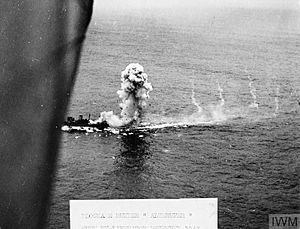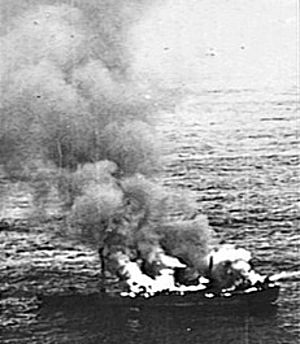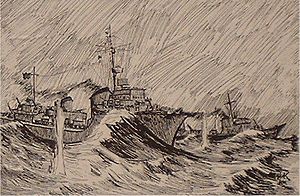Operation Stonewall facts for kids
Operation Stonewall was an important event during World War II. It was a mission to stop German ships, called 'blockade runners,' from bringing important supplies into German-controlled France. This operation showed how well different countries and military branches could work together.
Contents
Why Operation Stonewall Was Needed
When World War II began, the Allied countries tried to stop Germany from getting supplies by sea. This was called a 'blockade.' Germany had many resources, but it still needed some key materials like rubber, tin, and tungsten.
At first, Germany got these supplies using the Trans-Siberian Railway through the Soviet Union. But when Germany invaded the Soviet Union, this route closed. So, German and Italian ships that were stuck in places like Japan and Japanese-controlled Singapore started acting as 'blockade runners.' They tried to sneak these important goods into ports in German-occupied France.
The Allies did stop some of these ships, but a big, organized effort to catch them didn't start until December 1943. Many of these blockade runners were caught or sunk in the Atlantic Ocean and Indian Ocean.
The Operation Begins

In December 1943, the Royal New Zealand Navy ship HMNZS Gambia joined Operation Stonewall. It sailed from Horta in the Azores islands. Another ship, the Royal Navy cruiser HMS Glasgow, patrolled an area north of the islands.
On December 23, planes from the United States Navy ship USS Card spotted a ship they thought was a blockade runner. There were also reports of German destroyers escorting another merchant ship from France. The Gambia, Glasgow, and the cruiser HMS Enterprise formed a line to stop them. Planes attacked the group, which was now escorting a large incoming merchant ship called the Osorno. The planes reported hitting the Osorno once and nearly hitting it again.
More Allied ships joined the patrol to stop another blockade runner. These included the cruiser Penelope, the minelayer HMS Ariadne, and four Free French destroyers. RAF Coastal Command aircraft also worked closely with the ships.
Sinking of the Alsterufer
On December 27, a Liberator GR Mk V bomber from No. 311 Squadron RAF, which had a Czechoslovak crew, spotted a smaller blockade runner. This ship was the Alsterufer, a refrigerated cargo ship.
The Liberator plane attacked the Alsterufer with rockets, hitting it five times above the water. The plane also dropped two bombs, one of which hit the ship near its back. The Alsterufer immediately caught fire.
The Alsterufer fought back with anti-aircraft guns and rockets. The Liberator's engine was hit, but the plane made it back safely to its base in England. Later that day, other RAF planes attacked the burning ship, but didn't hit it again. The Alsterufer finally sank on the afternoon of December 28. Seventy-four of its crew members were saved by four Canadian ships.
Battle of the Bay of Biscay
German destroyers and torpedo boats had sailed out to meet and protect the Alsterufer. This mission was called Bernau. Now, the Allied ships Glasgow and Enterprise went to stop these German ships.
Guided by planes watching from above, the Allied cruisers found eight German destroyers on the afternoon of December 28. They started firing at each other. Even though the German ships fired accurately and tried to escape, and a German plane attacked with guided bombs, the Royal Navy ships kept fighting.
The German ships split into two groups, and the Allied cruisers chased one of them. By 4:00 PM, the German torpedo boats T25 and T26, and the destroyer Z27 were sunk. One German ship escaped, but it was damaged. About 62 German sailors were rescued by Royal Navy ships, 168 by an Irish ship called Kerlogue, and four by Spanish destroyers.
The blockade runner Osorno managed to reach the Gironde estuary in France. However, it hit a sunken wreck in the water. The crew had to beach the ship, and its cargo was unloaded from there.
The Glasgow, Enterprise, and Ariadne returned to Plymouth, England. The Penelope went to Gibraltar. More German blockade runners were expected from the Far East. So, the Gambia and the cruiser Mauritius patrolled north of the Azores for the next three days. The Gambia then returned to Plymouth on January 1, 1944.
Three more German ships were sunk between January 3 and 5 by US Navy patrols in the South Atlantic. These were the last German blockade runners. By the autumn of 1944, German armies were leaving France, and the French ports were no longer open for Axis ships.
Allied Participants
- Ships: Canada, France, New Zealand, United Kingdom, United States
- Aircraft: United Kingdom (including one with Czechoslovak crew), United States



